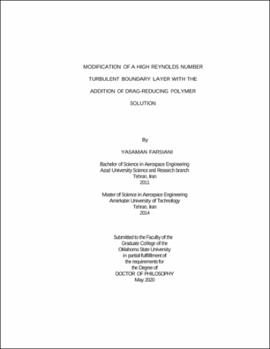| dc.contributor.advisor | Elbing, Brian | |
| dc.contributor.author | Farsiani, Yasaman | |
| dc.date.accessioned | 2020-09-09T21:16:31Z | |
| dc.date.available | 2020-09-09T21:16:31Z | |
| dc.date.issued | 2020-05 | |
| dc.identifier.uri | https://hdl.handle.net/11244/325498 | |
| dc.description.abstract | Polymer drag reduction (PDR) is an active flow control technique that has drawn significant scientific examination and industrial interest for over 70 years (e.g. fluid transport in oil pipelines, surface ships, safer fuels, drug delivery). While it is well known that trace amounts of polymer solutions can reduce drag by up to 80%, the fluid mechanism of how the polymers reduce the drag remains elusive. Recent findings have shown that polymer properties influence how PDR modifies the near-wall mean velocity profile, which is in contrast to the classical view. Consequently, the current study uses a novel technique to create a developing turbulent boundary layer within a homogeneous polymer solution (i.e. polymer ocean), in which polymer properties are sensitive to polymer concentration. This has never been attempted before due to known issues with polymer degradation, which this study includes an assessment of the impact of mechanical degradation on polymer drag reduction performance. The degradation study showed that degradation effects can have an impact on the performance, but these can be mitigated with sufficiently large residence times. The modifications to the velocity distribution are analyzed using particle image velocimetry. Analysis included comparisons between mean and fluctuating velocity profiles and proper orthogonal decomposition (POD). In addition, modifications to coherent structures were studying via two-point correlations between the fluctuating velocity components to reveal modifications to the intermittency of the near-wall events. Results show that for the controlled range of Reynolds number (800<Re[theta]¸<3000), a critical polymer dependent parameter, Weissenberg number (Wi), has a dominant effect on controlling the modified near-wall turbulence. Specifically, the polymers suppress wall-normal fluctuations while amplifying the streamwise fluctuations. For the coherent structures, the structure configuration is strongly dependent on Wi at high drag reduction (>40%). A linear relationship was identified between structure inclination angle, a, (in the TBL log-region), and drag reduction (DR), a=-0.563DR+46.9. Faster convergence of cumulative turbulent kinetic energy (TKE) of the POD modes was observed in polymeric cases, which signifies a smaller number of structures containing the total TKE compared to Newtonian flow. This further suggests that polymers are involved in severely mitigating the spatiotemporal evolution of vortical structure in the TBL near-wall region, a process that significantly contributes to the production of skin-friction drag. | |
| dc.format | application/pdf | |
| dc.language | en_US | |
| dc.rights | Copyright is held by the author who has granted the Oklahoma State University Library the non-exclusive right to share this material in its institutional repository. Contact Digital Library Services at lib-dls@okstate.edu or 405-744-9161 for the permission policy on the use, reproduction or distribution of this material. | |
| dc.title | Modification of a high Reynolds number turbulent boundary layer with the addition of drag-reducing polymer solution | |
| dc.contributor.committeeMember | Santhanakrishnan, Arvind | |
| dc.contributor.committeeMember | Sallam, Khaled | |
| dc.contributor.committeeMember | Hareland, Geir | |
| osu.filename | Farsiani_okstate_0664D_16685.pdf | |
| osu.accesstype | Open Access | |
| dc.type.genre | Dissertation | |
| dc.type.material | Text | |
| dc.subject.keywords | flow visualization | |
| dc.subject.keywords | polymer drag reduction | |
| dc.subject.keywords | turbulent boundary layer | |
| dc.subject.keywords | turbulent coherent structure | |
| dc.subject.keywords | velocity profile modification | |
| thesis.degree.discipline | Mechanical and Aerospace Engineering | |
| thesis.degree.grantor | Oklahoma State University | |
